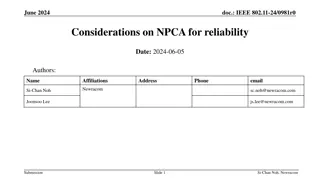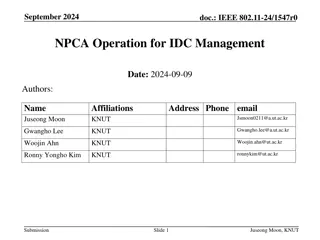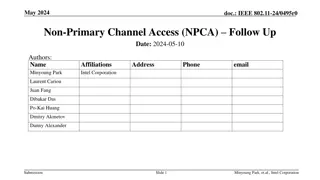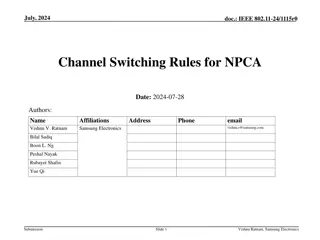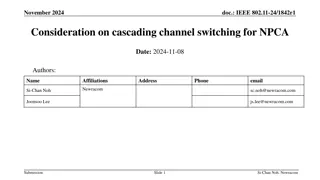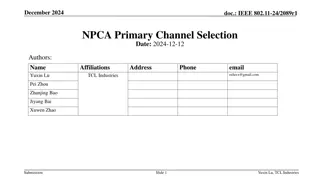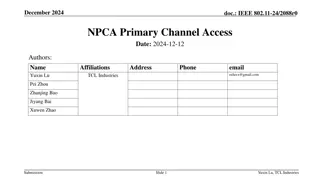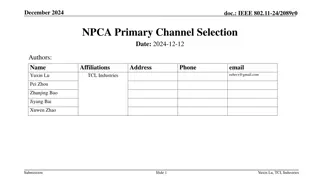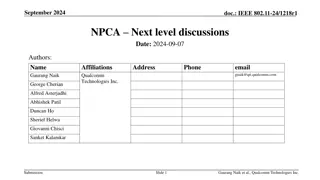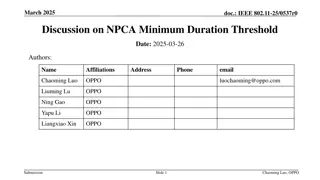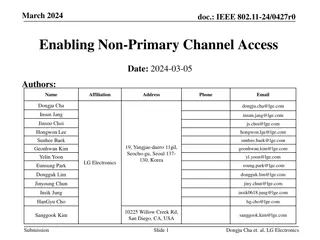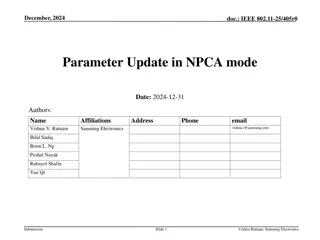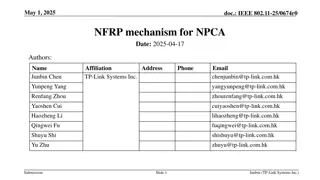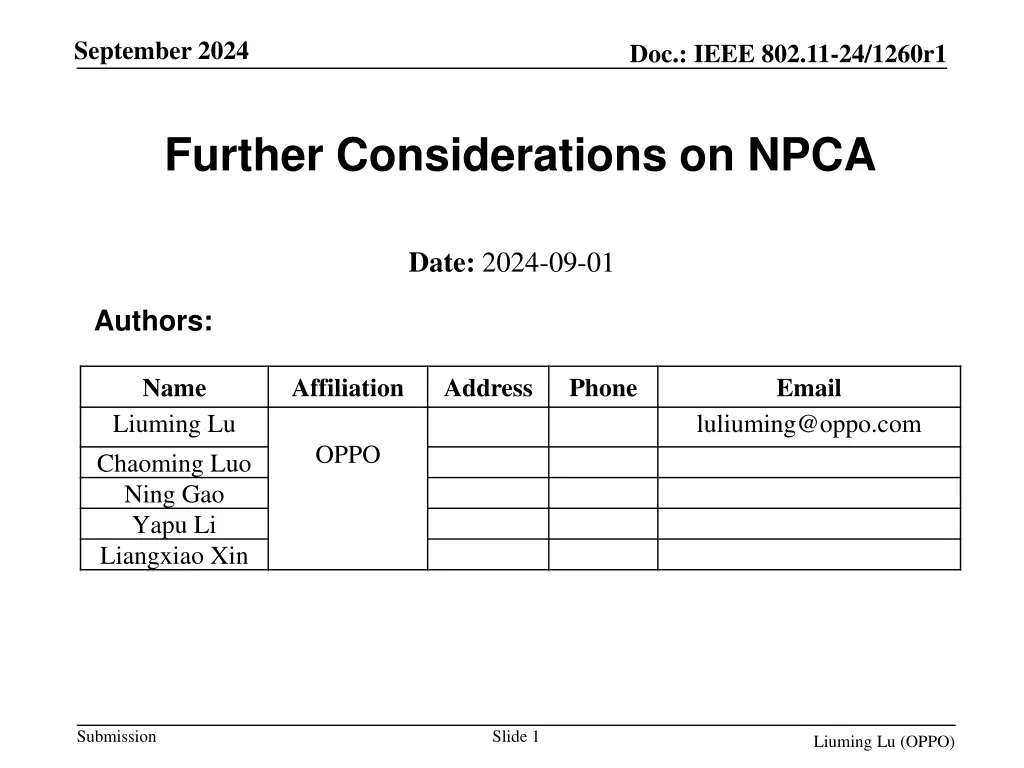
Issues Addressed in IEEE 802.11-24/1260r1 September 2024 Doc
Explore power consumption, medium synchronization, and channel switching issues in the September 2024 document of IEEE 802.11-24/1260r1, focusing on enabling STA access to the secondary channel amidst primary channel congestion and other conditions.
Download Presentation

Please find below an Image/Link to download the presentation.
The content on the website is provided AS IS for your information and personal use only. It may not be sold, licensed, or shared on other websites without obtaining consent from the author. If you encounter any issues during the download, it is possible that the publisher has removed the file from their server.
You are allowed to download the files provided on this website for personal or commercial use, subject to the condition that they are used lawfully. All files are the property of their respective owners.
The content on the website is provided AS IS for your information and personal use only. It may not be sold, licensed, or shared on other websites without obtaining consent from the author.
E N D
Presentation Transcript
September 2024 Doc.: IEEE 802.11-24/1260r1 Further Considerations on NPCA Date: 2024-09-01 Authors: Name Liuming Lu Chaoming Luo Ning Gao Yapu Li Liangxiao Xin Affiliation Address Phone Email luliuming@oppo.com OPPO Submission Slide 1 Liuming Lu (OPPO)
September 2024 Doc.: IEEE 802.11-24/1260r1 Introduction IEEE 802.11bn task group has agreed to define NPCA operation that enables a STA to access the secondary channel while the primary channel is known to be busy due to OBSS traffic or other TBD conditions There are several issues needed to be addressed for NPCA operation, such as power consumption issue for STAs supporting NPCA, blindness issue for STAs that switch to the NPCA primary channel, and non-synchronized channel switches for different STAs. This contribution analyzes the key issues for NPCA operation, and proposes candidate solutions for NPCA operation to be considered. Submission Slide 2 Liuming Lu (OPPO)
September 2024 Doc.: IEEE 802.11-24/1260r1 Issue 1 - Power Consumption Power consumption issue for STAs supporting NPCA AP can only exchange frames with one or several STAs on NPCA primary channel at a TXOP level. For STAs that switch to NPCA primary channel but cannot become a TXOP holder or TXOP responder, their switches may be inefficient. If unscheduled/uncontrolled and frequent switches between primary channel and NPCA primary channel happen to STAs, they may consume/waste a lot of power due to inefficient switches. AP2, STA2-1, STA2-2 STA2-2 switch to NPCA primary channel due to OBSS traffic between AP1 and STA1-1 AP1 AP2 Switch to NPCA primary channel AP2 obtains a TXOP on NPCA primary channel and initiate frame exchange with STA2-2. STA1-1 STA2-2 STA2-1 Although STA2-1 and STA2-3 switch to NPCA primary channel, their switches are inefficient as they cannot become a TXOP holder or TXOP responder. STA2-3 Figure. An example for the issues Submission Slide 3 Liuming Lu (OPPO)
September 2024 Doc.: IEEE 802.11-24/1260r1 Issue 2 Lost medium synchronization Blindness issue for STAs that switch to the NPCA primary channel. If AP/non-AP STA operating on their operating channel cannot perform CCA on its NPCA primary channel at the same time, when it switches to the NPCA primary channel it would loose medium synchronization on the NPCA primary channel. Especially when both AP and non-AP STA loose medium synchronization, it is difficult to handle this issue, which may result in collision for channel access. 11be has specified medium access recovery procedure to address blindness issue in NSTR link pair case, which can be used a reference. But the assumption of this mechanism is that AP doesn t loose its medium synchronization. Submission Slide 4 Liuming Lu (OPPO)
September 2024 Doc.: IEEE 802.11-24/1260r1 Issue 3 - non-synchronized channel switches non-synchronized channel switches for different STAs. For AP and non-AP STA, there is a case where the AP(or non-AP STA ) switches to the NPCA primary channel while the non-AP STA(or AP) does not switch to the NPCA primary channel, resulting in an non-synchronous channel switch for AP and non-AP STA AP1 AP2 AP2, STA2-1, STA2-2 switches to NPCA primary channel due to OBSS traffic between AP1 and STA1-1 Switch to NPCA primary channel STA1-1 STA2-3 If AP2 obtains a TXOP on NPCA primary channel and intend to initiate frame exchange with STA2-3, STA2-3 cannot response as it has not switched to NPCA primary channel. STA2-2 STA2-1 Figure. An example for the issues Submission Slide 5 Liuming Lu (OPPO)
September 2024 Doc.: IEEE 802.11-24/1260r1 Candidate Solution for Issue 1 Propose to provide a mechanism to manage STAs NPCA availability and unavailability A STA can indicate its NPCA availability/unavailability to the associated AP NPCA availability: the STA would switch to NPCA primary channel if the condition is met such as OBSS traffic is detected . NPCA unavailability: the STA may not switch to NPCA primary channel even if the condition is met. The associated AP should not initiate frame exchange with it on NPCA primary channel. The management of NPCA availability and unavailability is mainly applied for STAs in active mode. AP can also schedule the NPCA availability and unavailability of its associated STAs supporting NPCA Data PPDU STA1 STA1- -1 1 Data PPDU AP AP AP AP STA1 STA1- -2 2 ICF IR BA ICF IR BA STA STA 20MHz 20MHz Mangt. frame Mangt. frame Data PPDU OBSS PPDU2, Data PPDU OBSS PPDU1 BA BA BSS primary channle 20MHz) time time OBSS AP OBSS AP s s OBSS STA(s) OBSS STA(s) Schedule info. For Schedule info. For NPCA availability NPCA availability Schedule info. For Schedule info. For NPCA availability NPCA availability NPCA unavailability for STA1 NPCA unavailability for STA1- -2 2 NPCA unavailability for STA1 NPCA unavailability for STA1- -1 1 AP AP STA(s) STA(s) NPCA availability SP1 NPCA availability SP1 NPCA availability SP2 NPCA availability SP2 Submission Slide 6 Liuming Lu (OPPO)
September 2024 Doc.: IEEE 802.11-24/1260r1 Candidate Solution for Issues 2 & 3 A assisting link is introduced to address blindness issue and non-synchronized channel switch issue: Link1: supports NPCA operation Link2 (assisting link): assist Link1 to listen on the NPCA primary channel and do CCA operation ,and receive ICF if required Targets: 1. to ensure that AP1 doesn t loose medium synchronization on NPCA primary channel; 2. AP1 can receive ICF even it has not switched to the NPCA primary channel The same channel The same channel Link2 unavailability Link2 primary channel (Link1 NPCA primary channel) Link2 Link2 AP2 AP2 NPCA primary channel (20MHz) Switch delay IR BA NPCA AP MLD NPCA AP MLD 20MHz 20MHz beacon Link1 primary channel (20MHz) Link1 Link1 AP1 AP1 Time Time NPCA parameters set NPCA parameters set NPCA primary channel (20MHz) ICF Data PPDU AP1 AP1 STA1 STA1 STA STA Padding delay Padding delay 20MHz Non Non- -AP MLD/STA AP MLD/STA 20MHz Data PPDU OBSS PPDU BA Link1 primary channel (20MHz) STA1 STA1 Link1 Link1 OBSS AP OBSS AP s s OBSS STA(s) OBSS STA(s) Time Time An example: non-AP MLD set up only one link(i.e. Link1) with AP MLD Submission Slide 7 Liuming Lu (OPPO)
September 2024 Doc.: IEEE 802.11-24/1260r1 Summary There are several issues needed to be addressed for NPCA operation, such as power consumption/save issue for STAs supporting NPCA, blindness issue for STAs that switch to the NPCA primary channel, and non-synchronized channel switches for different STAs. This contribution analyzes the key issues for NPCA operation, and proposes candidate solutions for NPCA to be considered Propose to provide a mechanism to manage STAs NPCA availability and unavailability A assisting link is introduced to address blindness issue and non-synchronized channel switch issue Submission Slide 8 Liuming Lu (OPPO)
September 2024 Doc.: IEEE 802.11-24/1260r1 References [1] UHR proposed PAR, https://mentor.ieee.org/802.11/dcn/23/11-23-0480-01-0uhr-uhr-proposed- par.pdf [2] Draft P802.11be_D7.0 [3] non-primary channel access (NPCA) - follow up, https://mentor.ieee.org/802.11/dcn/24/11-24- 0495-00-00bn-non-primary-channel-access-npca-follow-up.pptx [4] Non-primary channel access (NPCA), https://mentor.ieee.org/802.11/dcn/23/11-23-2005-01- 00bn-non-primary-channel-access-npca.pptx [5] Robust Secondary Channel Access, https://mentor.ieee.org/802.11/dcn/24/11-24-0318-00-00bn- robust-secondary-channel-access.pptx Submission Slide 9 Liuming Lu (OPPO)
September 2024 Doc.: IEEE 802.11-24/1260r1 SP 1 SP : Do you support to specify a mechanism to manage the NPCA availability and unavailability of STAs supporting NPCA operation in 11bn? The mechanism is TBD Submission Slide 10 Liuming Lu (OPPO)
September 2024 Doc.: IEEE 802.11-24/1260r1 SP 2 SP : Do you support to specify a mechanism to address the blindness issue for STAs that switch to its NPCA primary channel and/or non-synchronized switches from primary channel to NPCA primary channel for STA and its peer STA(s) in 11bn? The mechanism is TBD Submission Slide 11 Liuming Lu (OPPO)



